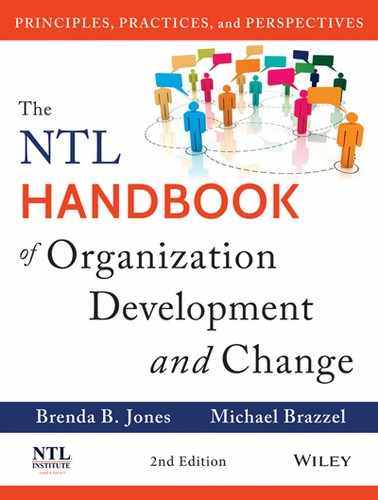CHAPTER FIFTEEN
TAPPING THE POWER OF EMERGENT CHANGE
Jill Hinson and David Osborne
“In the world of unknown unknowns, we can’t hope to precisely predict the behavior of critical systems, and we shouldn’t presume that we can manage behavior with precision either.”
—Thomas Homer-Dixon, 2009.
Leaders and organization development (OD) practitioners spend an enormous amount of time thinking about and planning for change efforts. Often leaders have in mind specific outcomes and a specific way the change should unfold. Yet, approximately 70 percent of change efforts fail. Research reveals that leaders feel change is both hard and slow (Hinson & Osborne, 2010). Leaders want change to happen faster. In fact, the world is demanding that organizations be more agile. Leaders share stories of employees resisting change. Often, change initiatives are stopped before any results are achieved. While all of these experiences of change can be true, change successfully happens everyday all around us. The ability to change and adapt is a natural capacity of all complex adaptive systems. Change happens through the process of self-organization, which leads to new emergent patterns within a system. This chapter explores self-organization and emergent change. The chapter outlines principles that enable emergent change and the implications and applications of these principles for change leaders and OD practitioners. Exhibit 15.1 describes the process used to collect research data for study and analysis.
Emergent change happens at both the individual level and the system level. What are some examples of emergent change? At the individual level, emergent change can shift one’s mental models. The experience of a flash of insight that suddenly changes our frame of thinking is an example of individual level emergent change. This flash comes suddenly and usually is not on our planned to-do list. At a global level, emergent change can alter the social fabric. An example of global level emergent change is the uprisings during the Arab Spring that changed governance structures. The exponential growth of social media and the Internet, which have changed how, when, and where we are connected, are further examples. In each of these instances, changes emerged without control or central planning. These changes happened rapidly, involving many interdependent elements interacting. So how can leaders and OD practitioners leverage this natural capacity to change? It will require an adjustment in our mindset and approach. It demands leaving behind the need for controlling change and adopting the approach of setting the conditions for change to emerge.
Spotlight: Emergence in Action
Let’s begin with a story (Rosenstein & Velleu, 2011) of change emerging naturally, without pre-planning or control. Within this story, notice the pattern of order emerging out of chaos through self-organization. The setting is Manhattan Island on September 11, 2001. Amid the horrific tragedy was the reality that hundreds of thousands of people were stranded, desperate to leave lower Manhattan Island. Every mode of ground transportation, including tunnels, bridges, and even the subway, was shut down. When the first World Trade Center building collapsed, terror and panic took hold. Water transportation was the only possibility; however, the few ferries available were quickly overwhelmed with people trying to get aboard. Some New Yorkers, desperate to leave, even dove into the Hudson River.
Instinctively, a few individual boat owners, passionately wanting to help, started allowing people aboard to transport them from the island. These boat owners began the initial patterns of rescue. Yet, the situation was extremely dangerous, with boats quickly becoming overloaded and precariously close to capsizing. Demand outweighed capacity. Commander Michael Day of the U.S. Coast Guard observed the unfolding pattern. Seeing both the need to transport people off Manhattan Island and the extreme volatility and riskiness of having individual boat owners rescue people, he made a critical choice. He issued this short and simple invitation to convene, “All available boats, this is the United States Coast Guard . . . anyone willing to help with the evacuation of lower Manhattan, report to Governor’s Island.” The invitation and official sanctioning within the message created safety for boat owners to join the effort.
The response was overwhelming; the commander’s action set in motion the emergence of a new evacuation pattern. Owners with boats of every size, shape, and type rapidly responded: private boats, fishing boats, tour boats, and tugboats. Without planning, training, or advanced coordination, the result was the most successful sea evacuation in human history. “Larger than the evacuation at Dunkirk, in World War II where 339,000 British and French soldiers were rescued over the course of nine days. On 9/11 almost 500,000 civilians were rescued from Manhattan by boat. It took less than nine hours” (Rosenstein & Velleu, 2011). This result was a 350 percent increase in productivity over the previous most successful water evacuation. Despite the horrific events of 9/11, those involved that day describe it as one of the best experiences of their lives. To dismiss this as a story of heroic action during crisis would overlook the lessons of the power of self-organization and it’s potential for rapid change and high performance. The six conditions that enable emergent change (drive for fitness, diversity, connectivity, safety, edge of chaos, and the right amount of control) were present during this situation. Exhibit 15.2 discusses the presence of the six conditions. To watch Boatlift, An Untold Story of 9/11 Resilience, visit www.youtube.com/watch?v=MDORZF7B2Kg.
Theoretical Framing from Complexity Science
“Accepting that uncertainty is fundamental to human organization life has important consequences.”
—Ralph D. Stacey, 2012.
Complexity science provides insight for leaders and OD practitioners on how to leverage this natural capacity for change. Complexity science, a multidisciplinary field, is the study of complex adaptive systems. It is drawn from a vast array of diverse sciences including systems theory, cybernetics, chaos theory, thermodynamics, and computational modeling; as such the language can be very complex and scientific (Marion, 1999). For the purposes of this chapter, the core concepts most useful for leaders and scholar-practitioners working in human systems will be presented. These concepts include complex adaptive systems, self-organization, patterns, and emergence. See Table 15.1 for a definition of these terms.
| Complex Adaptive System (CAS) | Complex adaptive systems are open systems comprised of diverse, interconnected agents or individuals. Examples of CAS are organizations, ant colonies, networks of neurons, the immune system, and the global economy. |
| Self-organization | Self-organization is the process of iterative individual local interactions that organize a system in a new way. Stacey (2012) asserts that this concept is not about “free-for-all” behavior or empowerment; but that individuals constrain and enable one another via their interactions. This process happens at the local or “micro” level. |
| Patterns | Patterns arise from repeated, recursive interaction and connection around differences with other agents. “Significant differences determine the primary patterns that emerge during self-organizing processes” (Olson & Eoyang, 2001). Pattern “watching” is a core capability of tapping into the power of emergent change. |
| Emergence | The ability for new global patterns to develop without the control of someone in charge. It is a common feature of complex adaptive systems where the behavior of the whole is much more complex than the behavior of its parts (Holland, 1995). Emergence happens at the global, “macro” level. |
TABLE 15.1. CORE CONCEPTS
Complexity science calls to question some of our long-held mental models of Newtonian thinking. (See Table 15.2.) Our thinking needs to shift from certainty to uncertainty, from simple causation to multi-dimensional causation, from parts to whole, from events to patterns. Leading an organization, as taught in today’s MBA schools, emphasizes analysis and rational decision making (Stacey, 2012). Success is achieved through attempting to predict the future and building a plan to capitalize on the future possibilities. While these approaches can be effective in a stable, predictable world, they become increasingly ineffective in an uncertain, unpredictable, rapidly changing complex world. Complexity science informs us that the world of CAS is indeed unpredictable. This unpredictability calls into question the effectiveness of our planning and controlling of change.
| From Newtonian View | To Complexity View |
| Planned | Emergent |
| Predictable | Unpredictable |
| Directive | Influence |
| Hierarchical | Inter-connection |
| Linear | Nonlinearity |
| Activities can be looked at in isolation | Interdependence prevails |
| Top-down change | Global patterns are created through local interactions |
TABLE 15.2. MINDSET SHIFT
Complex Adaptive Systems
A core building block of complexity science is complex adaptive systems (CAS). Complex adaptive systems are comprised of individuals, or groups of individuals that are diverse, interdependent, and connected. Examples of CAS are plentiful; they include traffic jams, playgrounds, the global marketplace, and an executive team meeting. In fact, all organizations, communities, and schools can be described as complex adaptive systems. But, what does this mean and how does this help us understand how to influence change?
In everyday life, we are constantly intermingled and entangled in multiple complex adaptive systems. Each interaction has the potential for surprise and novel impact that transforms the agents and the entire CAS. Within a CAS, individual interactions create system-wide patterns. It is these local interactions—individual conversations, cars stopping and going, and executives making decisions—that allow for new emergent patterns through their mutual connection and interactions. The system-wide patterns inform and constrain local interactions in a continual molding and evolving manner (see Figure 15.1). A complex adaptive system has no single governing element that controls the system. Instead, it has many distributed, interacting parts, each cooperating and competing independently. Simple rules of interaction influence the patterns that emerge (Holland, 1995). There is a constant, ongoing dance between agents as they co-evolve and build their collective future.
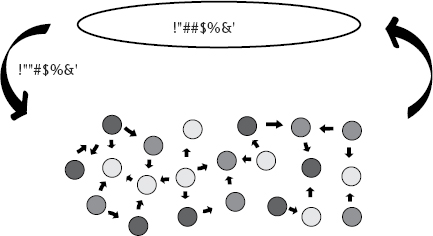
FIGURE 15.1. COMPLEX ADAPTIVE SYSTEMS (CAS) MODEL
CAS Properties
CAS have several important properties that inform how leaders and OD practitioners can affect change. Indeed it is these properties that call us to think differently about how change happens. Specifically, CAS demonstrate nonlinear properties, are sensitive to their initial conditions, and are capable of producing large, unexpected change. In short, they are unpredictable and uncertain. Any change leader who has worked on a change initiative can attest to the unpredictability of the experience. Yet, leaders and OD practitioners still act as if CAS are predictable. The following sections briefly describe each of these properties and their implication for change leaders.
Nonlinearity
The first property of CAS is that they are nonlinear in nature; agents’ interdependence creates this characteristic. Within a CAS, all agents are interacting; each of these interactions has the potential to multi-dimensionally alter the environment. Our Newtonian mental model tells us that cause and effect are directly proportionate to each other. If a leader wants a big outcome or change, they need a big plan. In math, linear equations can be neatly added up; the sum of the parts equals the whole. This simple, additive property is not true in a CAS. Nonlinearity produces exponential events and disproportionality between cause and effect. Nonlinear equations cannot be added together in a simple manner; they have multi-faceted dependencies. Nonlinearity in organizations means that relationships have interdependence on one another. For example, crop prices spike due to drought; the higher food prices impact restaurants, employees, and individual families. Weather in one part of the world can have a wide impact. Another example is when new regulations change the landscape of an entire industry, creating revolutionary change. Gleick (2008) described this well, “Nonlinearity means that the act of playing the game has a way of changing the rules.” For leaders and practitioners, nonlinearity translates into the need to be comfortable with uncertainty, the importance of pattern watching, and practice of adopting of iterative actions.
Sensitive to Initial Conditions
A second CAS property is that they are sensitive to initial conditions. “Tiny differences in input could quickly become overwhelming differences in output—a phenomenon given the name “sensitive dependence on initial conditions” (Gleick, 2008). Small decisions in the past change future outcomes. History matters. Furthermore, small differences, unknown to leaders and OD practitioners, can cause different patterns or outcomes to emerge. This is one of the reasons predicting an exact outcome of a change initiative is difficult. Lorenz, an MIT mathematician and early contributor to chaos theory, coined the phrase butterfly effect when he discovered that weather patterns change dramatically based on small variations in initial conditions (1972). This principle has been popularized in the movie and literary industry: a character goes back in time and changes a small action in the past, and their change leads to a vastly different future. Armed with this knowledge, change leaders acknowledge predictability is an impractical belief. CAS are sensitive to their unfolding history. Small and large events in the past will influence future patterns.
Capable of Producing Sudden Large Events
Complex systems are capable of producing sudden large events; this concept is the third property of CAS. A complex system can self-organize to a critical state. A critical state is often called at “the edge of chaos.” Many small events happening within the system contribute to the unstable, critical state. At the peak of this state, a seemingly small event can cause a disproportionately large event (Bak, 1996). For leaders and OD practitioners, this means change may appear to be moving slowly, with only small changes happening; then suddenly a “tipping point” unfolds into a larger change or transition (Gladwell, 2000). Change in CAS happens in fits and starts; it does not follow a predictable linear, step-by-step timeline.
Self-Organization and Emergence
Self-organization is the process by which CASs organize into novel ways of working; this process leads to the emergence of new global patterns. Prigogine found self-organization present in thermodynamics (1984). Imagine a pot of water. Sitting still in its pot, it is in a stable state. When the environment changes, for example, when the heat is turned on, the water co-evolves and starts to change. Random bubbles start appearing, steam may appear, and then there is a shift and the water starts to boil, turning into steam. Self-organization happens naturally as water molecules interact with each other and their environment. “In their local interactions, humans agents constrain and enable each other. The patterns that emerge do so because of what every agent is doing or not doing.” For example, when a team is brought together, the enabling and constraining interactions can create emergence of a number of patterns; effective working patterns, conflict or in fighting. Stacey further states, “No one individual can be organizing his or her experience in isolation because they are all simultaneously evoking and provoking responses in each other” (2012). A hallmark of self-organizing is the need for exchange of energy and resources with the environment; spontaneity and learning is an outcome of self-organizing (McMillian, 2004; Michaels, 2000).
Biologist Stuart Kauffman has identified five preconditions for change to occur through self-organization (1995). These conditions include having a safe, “nutrient rich” environment, the search for fitness, high levels of diversity, complexity of connections, and the right balance of chaos and order. Control or designed order limits the potential for self-organization. We will explore each of Kaufman’s conditions that enable change.
A Safe, “Nutrient-Rich” Environment
The condition of safety and a “nutrient-rich” environment ensures that the essential elements needed for sustenance are exchanged between the CAS and its environment. Feedback loops between the environment and individual agents provide energy, information, and other resources needed. In human systems this includes the psychological safety for individuals to have robust and meaningful interactions. For leaders and OD practitioners, safety enables dialogue. This condition also ensures that the right information—nutrients for change are being provided for the CAS.
Search for Fitness with the Environment
Fitness with the environment means the continual search to fit into the environment in the best possible way. “Fitness exists when a system reaches a functional relationships with the environment, enabling an adequate level of energy flow for survival” (Michaels, 2000). Since the landscape and environment the CAS “lives” in is undergoing change, the CAS itself needs to be in constant search for fitness. A search for fitness to the environment must be present for change, or emergence, to happen within a CAS. To be in “fitness” with the environment, there needs to be robust feedback loops and interconnectivity with the surrounding elements.
High Level of Diversity
Diversity is a key ingredient that enables change. Sameness breeds sameness. Diversity provides the ingredients for novelty. Consider an example from chemistry. When the diverse elements, hydrogen and oxygen, come together as H2O something new emerges; water is created. The integration of diverse perspectives and ideas enables novelty. For leaders and OD practitioners, the exchange of diverse ideas creates insights that lead to innovation.
Complexity of Connections
Diversity alone is not enough. Complexity of connections enables diversity to be leveraged. The diverse parts of a CAS need to be connected in a way that enables the flow of information and ideas. Consider how increased connectivity provided by the Internet and social media have changed our lives. Adjusting the means and degrees of connectivity enables the sharing of information, diverse perspectives, and the social diffusion of change. For emergence to unfold, sparsely connected agents need to be connected.
The Right Balance of Chaos and Order
The right balance between chaos and order is needed for change to emerge. Yes, there is the need for messiness and chaos alongside the order. A CAS that is stable, in an “orderly state,” has a lower propensity for change. The system is too rigid and tightly bound. Yet, a CAS in chaos is too random to allow a new pattern to fully form. Emergence happens at the edge of chaos. Leaders need to understand the resilience of patterns within the system they lead; they need to understand when to stabilize the system and when to disturb the system.
Complexity science shifts our Newtonian paradigm. It informs leaders and change agents that by attending to local interactions, enabling the conditions in the CAS, and expecting unpredictability, emergence can unfold. The illusion of control and the desire to tightly bind a system inhibit this natural transformational process. By understanding that organizations are unpredictable, connected, interdependent, and multi-dimensional, change agents may experiment, convene, adapt, sense patterns, and skillfully disrupt systems.
Applying the Lessons of Complexity Science
“Complexity theory suggests that that most powerful processes of change occur at the micro level, where relationships, interactions, small experiments, and simple rules shape emerging patterns.”
—Olson and Eoyang, 2001.
How can change leaders influence change in CAS given their inherently unpredictable nature? This section explores how change leaders can set conditions to influence the speed and direction of change. Since leaders and change agents cannot expect change to happen in neatly described phases or through linear plans, they need to find alternative ways to enable the inherent adaptive capacity of systems. Enabling change though the complexity lens means understanding how individual change occurs, convening of “agents” to allow the social diffusion. Leaders need to intentionally consider individual interactions and social diffusion or tipping points.
Six change “dials” are introduced. Change leaders need to continually monitor and tune these dials. This section shares an organization spotlight on how to use these change dials. Finally, the chapter outlines five lessons for change based on the change dials. Change leaders influence change in a CAS by tuning these six dials.
Change Dials™
Despite the prevalent uncertainty, leaders and change agents have an important role in supporting change. Their role shifts from planning change to creating conditions for change. Kauffman’s preconditions provide focal points for change leaders (1995). These focal points become change dials that can be increased or decreased to enhance conditions for change. While prediction is unlikely, change agents can influence the speed and direction of change by attending to these “dials.” The six dials are drive for fitness, diversity of views, connectivity, safety, edge of chaos, and control. (See Figure 15.2.) Each dial is briefly described, then potential actions change agents can take to affect each dial are provided. By “tuning” the dials, change agents increase the propensity for emergent change.

FIGURE 15.2. CHANGE DIALS
Dial 1: Drive for Fitness
The drive for fitness, Figure 15.3, is the CAS’s desire and need for something to be better than or different from the current state. It reflects how the individual, group, or organization fits with the surrounding environment. Declining sales, unhappy customers, technological innovations, competitive activity, or new regulations may all create a need and desire for greater fitness with the environment. The dial indicates the degree of motivation a system has to adapt; it reflects the affective, cognitive, or somatic need to change. The drive for fitness includes desire for improvement at an individual, team, and organization level. Without this drive there is an absence of motivation for something different. Change agents often need to tune this dial up to ensure a felt sense of urgency for improvement.

FIGURE 15.3. DIAL 1: DRIVE FOR FITNESS
Ways to tune the “drive for fitness” dial include:
- Establish and communicate measures that continually monitor external fitness.
- Connect individuals in explorations of the environment around them.
- Encourage “sense-making” among agents to clarify new external emerging patterns.
Dial 2: Diversity of Views
The second dial, diversity of views, Figure 15.4, refers to the amount of variation within the system. Are there individuals providing diverse perspectives, knowledge, or ideas to the system? Diverse perspectives increase the potential to generate insight and innovation. Hierarchical structures foster silos and fragmentation of information. Sharing diverse perspectives across silos, levels, or the external environment helps create a broader view of the whole. Conversely, diversity of views can create conflict that is difficult to overcome. Change agents need to monitor and nurture the flow of diverse views, while dampening unhealthy conflict that can fragment a system. Change agents need to pay attention to when to dial up or dial down this dial to ensure optimal differentiation.

FIGURE 15.4. DIAL 2: DIVERSITY OF VIEWS
Ways to tune the “diversity of views” dial include:
- Support the norm “expectation to dissent” to ensure the patterns of communication do not constrain differences; highlight the core differences that matter.
- Dampen differences that create fragmentation and decoupling.
- Involve the whole system in building understanding and cohesive meaning.
Dial 3: Connectivity
The connectivity dial, Figure 15.5, refers to the quantity and quality of interconnections within a system. Increasing or decreasing connectivity affects the transfer of information and resources. Greater connectivity enables rapid transfer and deeper idea sharing. Connecting disparate functions increases adaptation speed. Change agents need to spend time understanding how they can tune up connectivity to develop robust social change networks that have high quality, resilient connections. Highly connected systems can rapidly diffuse change across the whole system.

FIGURE 15.5. DIAL 3: CONNECTIVITY
Ways to tune the “connectivity” dial are
- Connect disconnected parts of the system; foster relationships and connection between silos.
- Identify single points of failure or bottlenecks for information flow; then develop alternative flows of information and resources.
- Increase the quality of conversations.
Dial 4: Safety
The safety dial, Figure 15.6, encompasses how psychologically safe it is to challenge the status quo, take risks, or share divergent points of views. Increasing or decreasing safety affects the propensity of individuals to interact and develop new ways of thinking and working together. Safety enables the level of dialogue that supports collaboration, innovation, and agility. Is it safe to take risks? Is it safe to challenge the status quo? Can we fully express ourselves and share our diverse perspectives? A key role of a change leader is to create the safe space for the diverse ideas and perspectives to be shared. Change agents need to develop the right amount of system safety so that individuals have freedom to act.
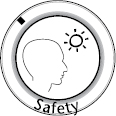
FIGURE 15.6. DIAL 4: SAFETY
Ways to “tune the safety” dial are
- Maintain a calm, confident presence in the face of adversity, fear, and group anxiety.
- Replace blame with a future oriented learning perspective; ensure no retribution for actions.
- Allow experimentation; encourage failing safely.
Dial 5: Edge of Chaos
The edge of chaos dial, Figure 15.7, focuses on the degree of stability in the system. Being at the edge of chaos, the system is at a critical state and poised for transformation. Small actions can produce dramatic effects. In a stable environment, there is not much need for change, and because there is little change in the environment, there is less opportunity for a new pattern to emerge. When everything around us is changing there are both opportunities and threats. The probability and potential for change increase dramatically. When systems are stable, change leaders need to create disruption.
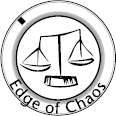
FIGURE 15.7. DIAL 5: EDGE OF CHAOS
Way to stabilize a system include:
- Define what is certain and what is uncertain.
- Clarify roles, short term goals, and action steps.
- Provide information and increase communication channels.
Ways to disrupt a system include:
- Reorganize teams or organizations.
- Increase connectivity with diverse stakeholders or the external environment.
Dial 6: Control
The control dial, Figure 15.8, refers to the degree of system autonomy. When systems are rigidly controlled, there is less opportunity for novel ideas and approaches to emerge and be adopted. Control can stifle initiative, a hallmark of self-organization. Conversely when control is too loose, it can be very difficult to build coherent patterns. Balancing control in a manner that enables individual initiative, yet sets important minimum boundaries for behavior, allows change. Change agents often need to coach leaders to loosen control to allow autonomy.
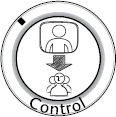
FIGURE 15.8. DIAL 6: CONTROL
Ways to tune the “control” dial are
- Empower cross-organization teams to deal with critical issues.
- Increase/decrease decision making authority—delegate to the lowest possible level.
- Adopt simple rules to guide decisions and behavior.
There is no “right answer” or one “way” for how to create change. Each situation, organization, culture, and system has a unique history, pattern, and environment. The change dials help us focus on the elements that can be adjusted to support change emerging from self-organization. Let’s take a look at a real example of how the change dials were adjusted to nurture change in a high-stress, highly conflicted organization setting.
Spotlight: Change Dials in Action
For ease of comprehension, this spotlight is being described in a linear fashion; however, the situation was multi-dimensional and non-linear. The dials are interconnected; changing one dial will alter other dials.
Situation Overview: A leader needed three functional areas to work more effectively cross-organizationally. The patterns the leader observed within the functions included tense relationships, volatile conflict, ad-hoc work processes, siloed functions, low trust, and information hoarding. Despite these internal patterns, the division was recognized for delivering phenomenal results. The emotional toll however, was very high for the people involved. While the leader wanted the team to work together better, there wasn’t a specific picture of what “better” would look like or a plan on how to become “better.” The consulting work focused on tuning the change dials to enable emergent change. For each dial, the initial patterns are described, and then the dial tuning is depicted. Table 15.3 summaries this spotlight. Figures 15.9, 15.10, 15.11, and 15.12 show some dials and combinations to be discussed.
| Change Dial | Initial Patterns | Dial Tuning |
| Drive for Fitness | Low at group level; high at individual level | Team session to build shared knowledge of the individual desire to change. By changing this dial, the edge of chaos dial was impacted. |
| Safety | Low at group and individual levels | The leader role modeled being vulnerable. Information that was previously held by leaders was shared only in transparent ways. Sessions were designed to provide information in confidential ways until more safety was developed. By changing this dial, the diversity dial was impacted. |
| Diversity | Low at group level | The group was brought together in multiple ways to increase connectivity of diverse groups and individuals. Voices of quiet members were encouraged; perspectives were shared across roles and teams. This increased innovation and drive for fitness. |
| Connectivity | Low at group level | Whole function sessions connected the whole; group sessions connected team members; cross-functional process sections connected silos. By changing this dial the diversity, edge of chaos and control dials were impacted. |
| Edge of Chaos | System very stable | Increased awareness of shared desire for change, the leaders encouragement toward this change, and new expectations to contribute toward the change all shifted the dial. |
| Control | High | Meetings were changed from being mandatory; the leader’s role shifted from providing answers to listening and allowing initiative. By changing this dial, the safety dial was impacted. |
TABLE 15.3. SPOTLIGHT DIAL TUNING SUMMARY

FIGURE 15.9. DIAL 1: DRIVE FOR FITNESS

FIGURE 15.10. DIAL 2 AND DIAL 4

FIGURE 15.11. DIAL 3
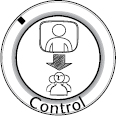
FIGURE 15.12. DIAL 6
Dial 1: Drive for Fitness
Initial patterns: In one-on-one meetings, individuals expressed very strong frustration; every team member wanted things to change. Individually the “drive for fitness” was high. Yet, they believed that nothing would change, therefore never talked to each other about their desire for improvements. Individual “drive for fitness” while high was fragmented at the group level.
Tuning the dial: To tune this dial, we needed to change the pattern of isolation and build a sense of the whole. We initiated a series of whole team conversations to build connection between the individuals. In this global setting, individuals were invited to share their stories of what it was like to work there. Some employees talked about dreading to come to work in the morning, others about how they hated the tense environment. Simultaneously, they shared stories of deep commitment to the organization’s mission. We then invited individuals to share their dreams of a better the work environment. The leader shared her stories of frustration and deep desire for a more productive workplace. The interactions started to shift the global pattern; the drive for fitness was present. Many employees reported the environment being much lighter and friendlier the following week. The patterns shifted; the status quo was no longer acceptable.
Dial 2: Diversity of Views and Dial 4: Safety
Initial patterns: There was little safety with the functions. Teams with adjacent offices rarely spoke. Individuals described a tense environment; hand-offs between teams were strained. These factors suppressed the expression of diverse views. The history of distrust and conflict had left frayed relationships.
Tuning the dial: A simple yet powerful change to norms created a disruption in the system. Typically, all meetings were mandatory. Instead, we worked with the leader to change this norm from no-choice to choice. A norm of autonomy was developed; individuals were invited to conversations and meetings with no requirement to attend. This was very different from the practice of mandatory attendance.
These meetings were designed to increase safety. The meeting designs included small group work, large group interactions, use of visual imagery, and collecting and sharing individual perspectives anonymously. In addition, the leader adapted her behavior to create safety. She began to listen more and judge less. In addition, she role modeled vulnerability and disclosed that she did not have the answers and that she needed the groups help. As interaction and engagement built, others became curious about what was happening. The social diffusion was beginning.
Dial 3: Connectivity
Initial patterns: At the onset of this project, individuals worked independently. Teams rarely interacted with other teams unless necessary. There were patterns of fragmentation and information hoarding.
Tuning the dial: The connectivity dial was also adjusted. In collaboration with the group, a series of meetings were established. Each meeting combined different configuration of team members. For example, they were one on one meetings, team meetings, cross-functional meetings, and whole group meetings. During cross-functional teams meetings, the group reviewed core work processes to improve effectiveness, focusing on handoffs and boundaries crossing. Inter-team meetings explored opportunities to work better together. Finally, large group meetings were established to share progress and build shared commitment to new approaches that emerged from the group. Gradually the pattern shifted from isolation and silos to realization of the value of connecting and talking.
Dial 6: Control
Initial patterns: The leadership style was autocratic, with a heavy emphasis on top down communication. The leader made the majority of decisions unilaterally.
Tuning the dial: Meeting became optional versus mandatory. In addition rather than mandating a direction, the leader invited the team to create a shared vision of the work environment they wanted. Throughout the change, collaborative decision-making processes were utilized to identify and agree on action plans. Teams were empowered to negotiate working relationships with each other versus the norms being mandated top down. These changes increased autonomy and reduced the degree of control.
By focusing on tuning the dials, the team transformed their working patterns. The team took ownership for improving work processes and making individual changes. The environment became more supportive, interactions between teams became more collaborative, and work issues were resolved rapidly. Perhaps more importantly, the group discovered they could work together to improve and change.
Lessons to Accelerate Change
To leverage organization’s adaptive capacity change leaders need to tap into the collective potential of the whole organization. Change leaders enable change by being champions of connectivity. They often need to disrupt the status quo and be comfortable with ambiguity. Here are five lessons we have found enable success.
Lesson 1: Sense Strategically
A change leader in a chaotic environment senses the external patterns that are emerging. Strategic sensitivity enables an organization to be agile and adaptive, and is a key source of competitive advantage. Change leaders need to find varied ways to tap into what is emerging externally. For example, one high-tech leader in our study established the role of “corporate wanderers”—individuals with no formal job description, whose only responsibility was to explore possible new trends (ChangeFusion, 2010). This lesson harkens to the drive for fitness dial.
Lesson 2: Be a Disruption Creator
A change leader encourages creativity and supports the exploration of ambiguity and experimentation. A disruption creator knows that innovation happens at the edge of chaos. When organizations become too comfortable and like-minded, they are less likely to be adaptive and innovative. According to the 2010 IBM global CEO study, “Leaders said they must be ready to upset the status quo even if it is successful. They must be comfortable with, and committed to, ongoing experimentation.” As an example, Google is committed to allotting 20 percent of employee time to working on projects of the employees’ own choosing (The Engineer’s Life at Google, 2010). As a “disruption creator,” leaders disrupt the comfort zone allowing opportunities to emerge. This lesson is drawn from the edge of chaos dial.
Lesson 3: Convene
Change occurs naturally by bringing together diverse people to have dialogues about important issues. When we convene a group of diverse people to have dialogue about an important issue they care about, we create the conditions for self-organization. Kanter (2009) describes it: “As leadership shifts away from hierarchical decisions at the top that are slowly cascaded downward, to social networks and self-organizing, knowing how to use convening power becomes critical.” She provides the example of the Clinton Global Initiative (CGI) that was formed to address significant global problems through a series of centrally led projects. CGI realized that, by convening large groups of people who cared about the issues, they created more momentum by doing less. They shifted control from a top-down approach to power at the local level. “It gets people who already have their fingers on the levers of change moving quickly.” Leaders need to let go of control and trust the passion and wisdom of the whole. This lesson supports the connectivity dial.
Lesson 4: Become a Connector
A change leader builds bridges across disparate parts to increase innovation and diversity of ideas. A leader in the high-tech industry shared with us how his organization applies this concept by investing time to partner with customers. During four-day conferences, the organization and its customers interact to learn about challenges in the field and develop solutions together (ChangeFusion, 2010). P&G’s revolutionary “Connect and Develop” product development approach leverages the principle of increasing connectivity. P&G shifted their approach from a tightly controlled and secretive internal product development process to connecting openly with external innovators and engineers globally. The result was a dramatic increase in the number of new products with reduced development times that fueled accelerated business growth. Enhancing connections accelerates the speed of ideas and mobilizes action where and when it is needed. This lesson tunes the connectivity dial.
Lesson 5: Stabilize
A change leader can bring a presence of calm and confidence in the midst of the anxiety and fear that accompany chaos and complexity. John Kenneth Galbraith (Galbraith & Buck, 1977) said, “All of the great leaders have had one characteristic in common: it was the willingness to confront unequivocally the major anxiety of their people in their time. This, and not much else, is the essence of leadership.” Emotional contagion is a well-researched phenomenon that involves the emotions of one person transferring to another person. Typically, this transfer is through unconscious methods of non-verbal mimicry and feedback: we automatically mimic the facial expressions, body language, speech patterns, and vocal tones of others. We are hardwired to mimic others outwardly; mirror neurons facilitate this dynamic. By maintaining a calm presence, leaders can transform the anxiety of the organization. Practices that support the presence needed to stabilize include meditation, mindfulness and other Eastern-influenced modalities. Mindfulness enables a leader to be a stabilizer. This lesson tunes the safety dial. (Osborne & Hinson, 2011).
Closing Thoughts
Chaos and unpredictability present opportunities and threats. By working with the principles of self-organization, change leaders can leverage the forces that support change to naturally emerge. This involves a mindset shift from a notion of centralized control to tapping into collective intelligence, from linear cause and effect thinking to sensing patterns and leveraging self-organizing power. While not being able to control and predict change, we can create conditions for change. Through this, leaders influence the speed and direction of change.
Special Thanks and Acknowledgements
NTL Institute. NTL has provided a multitude of mentors and guides as we have learned and experienced the foundational principles of influencing change.
HSD Institute. Glenda Eoyang, founder of the Human Systems Dynamics Institute, has been an important guide and mentor to us during our ongoing journey exploring complexity science. Our approach to change in complex times is deeply informed by her theories and work.
Harrison Owen, discoverer of open space technology, is a visionary proponent of how principles of complexity and self-organization work in human systems. His wisdom and passion have provided insight into the chapter’s concepts.
References
Bak, P. (1996). How nature works: The science of self-organized criticality. New York: Copernicus.
Galbraith, J. K., & Buck, B. (1977). The age of uncertainty. Boston, MA: Houghton Mifflin.
Gladwell, M. (2000). The tipping point: How little things can make a big difference. New York: Little Brown Company.
Gleick, J. (2008). Chaos: Making a new science. London: Penguin.
Goldstein, J. (1994). The unshackled organization: Facing the challenge of unpredictability through spontaneous reorganization. Portland, OR: Productivity Press.
Hinson, J., & Osborne, D. (2010). Strategy, leadership and change research. Falls Church, VA: ChangeFusion and Northern Virginia Technology Council.
Holland, J. H. (1995). Hidden order: How adaptation builds complexity. New York: Helix Books.
Homer-Dixon, T. (2009). The newest science: Replacing physics, ecology will be the master science of the 21st century. Alternatives Journal, 35(4), 8–11.
Kanter, R. M. (2011, September 9). Bill Clinton and how to use convening power. Harvard Business Review Blog. Retrieved from http://blogs.hbr.org/kanter/2011/09/bill-clinton-and-how-to-use-co.html
Kauffman, S. (1995). At home in the universe: The search for the laws of self-organized complexity. New York: Oxford University Press.
Lorenz, E. (1972, December 29). Predictability: Does the flap of a butterfly’s wings in Brazil set off a tornado in Texas? Paper presented at annual meeting of American Association for the Advancement of Science, Washington, D.D.
Marion, R. (1999). The edge of organization: Chaos and complexity theories of formal social systems. Thousand Oaks, CA: Sage.
Marion, R., & Uhl-Bien, M. (2002). Leadership in complex organizations. The Leadership Quarterly, 12(4), 389–418.
McMillian, E. (2003). Complexity, organizations and change. London: Routledge.
Michaels, M. (2000). The quest for fitness: A rational exploration into the new science of organization. Lincoln, NE: Writers Club Press.
Olson, E. E., & Eoyang, G. H. (2001). Facilitating organization change: Lessons from complexity science. San Francisco, CA: Pfeiffer.
Osborne, D., & Hinson, J. (2011). Leading in complex times. Practicing Social Change, 1(4), 26–30.
Prigogine, I., & Stengers, I. (1984). Order out of chaos: Man’s new dialogue with nature. New York: Bantam Books.
Rosenstein, E., & Velleu, R (Directors). (2011, September 8). Boatlift [Short film]. United States: Eyepop Productions. Retrieved from www.youtube.com/watch?v=MDORZF7B2Kg
Stacey, R. D. (2010). Complexity and organizational reality: Uncertainty and the need rethinking management after the collapse of investment capitalism. London: Routledge.
Stacey, R. (2012). Tools and techniques of leadership and management: Meeting the challenge of complexity. London: Routledge
The engineer’s life at Google. Accessed on September 1, 2010. Retrieved from www.google.com/jobs/lifeatgoogle/englife/index.html
